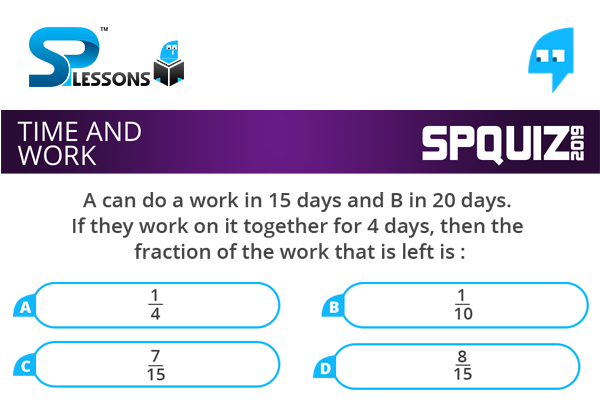 Introduction
Introduction
Time and Work is one of important topic in Quantitative Aptitude Section. In Time and Work – Quiz 1 article candidates can find a question with an answer. By solving this question candidates can improve and maintain, speed, and accuracy in the exams. Time and Work - Quiz 1 questions are very useful for different exams such as IBPS PO, Clerk, SSC CGL, SBI PO, NIACL Assistant, NICL AO, IBPS SO, RRB, Railways, Civil Services etc.
 Q1
Q1
A can do a work in 15 days and B in 20 days. If they work on it together for 4 days, then the fraction of the work that is left is :
- A. [latex]\frac{1}{4}[/latex]
B. [latex]\frac{1}{10}[/latex]
C. [latex]\frac{7}{15}[/latex]
D. [latex]\frac{8}{15}[/latex]
A's 1 day's work = [latex]\frac{1}{15}[/latex]
B's 1 day's work = [latex]\frac{1}{20}[/latex]
(A + B)'s 1 day's work = [latex]( \frac{1}{15} +\frac{1}{20}) = \frac{7}{60}[/latex]
(A + B)'s 4 day's work = [latex]( \frac{7}{60} \times 4) = \frac{7}{15}[/latex]
Therefore, Remaining work =[latex](1 - \frac{7}{15}) = \frac{8}{15}[/latex]
 Q2
Q2
A can lay railway track between two given stations in 16 days and B can do the same job in 12 days. With help of C, they did the job in 4 days only. Then, C alone can do the job in:
- A. [latex]9 \frac{1}{5}[/latex]
B. [latex]9 \frac{2}{5}[/latex]
C. [latex]9 \frac{3}{5}[/latex]
D. 10
(A + B + C)'s 1 day's work = [latex]\frac{1}{4}[/latex],
A's 1 day's work = [latex]\frac{1}{16}[/latex],
B's 1 day's work = [latex]\frac{1}{12}[/latex]
Therefore C's 1 day's work = [latex]\frac{1}{4} - (\frac{1}{16} + \frac{1}{12}) = (\frac{1}{4} + \frac{7}{48})= \frac{5}{48}[/latex]
So, C alone can do the work in [latex]\frac{48}{5} = 9 \frac{3}{5}[/latex]days.
 Q3
Q3
A, B and C can do a piece of work in 20, 30 and 60 days respectively. In how many days can A do the work if he is assisted by B and C on every third day?
- A. 12 days
B. 15 days
C. 16 days
D. 18 days
A's 2 day's work = [latex](\frac{1}{20} \times 2) = \frac{1}{10}[/latex]
(A + B + C)'s 1 day's work = [latex](\frac{1}{20} + \frac{1}{30} + \frac{1}{60}) = \frac{6}{60} = \frac{1}{10}[/latex]
Work done in 3 days = [latex](\frac{1}{10} + \frac{1}{10}) = \frac{1}{5}[/latex]
Now, [latex]\frac{1}{5}[/latex] work is done in 3 days.
i.e, Whole work will be done in (3 x 5) = 15 days.
 Q4
Q4
A is thrice as good as workman as B and therefore is able to finish a job in 60 days less than B. Working together, they can do it in:
- A. 20 days
B. 22 [latex]\frac{1}{2}[/latex] days
C. 25 days
D. 30 days
Ratio of times taken by A and B = 1 : 3.
The time difference is (3 - 1) 2 days while B take 3 days and A takes 1 day.
If difference of time is 2 days, B takes 3 days.
If difference of time is 60 days, B takes [latex](60 \times \frac{3}{2})[/latex] = 90 days.
So, A takes 30 days to do the work.
A's 1 day's work = [latex]\frac{1}{30}[/latex]
B's 1 day's work = [latex]\frac{1}{90}[/latex]
(A + B)'s 1 day's work = [latex](\frac{1}{30} + \frac{1}{90}) = \frac{4}{90} = \frac{2}{45}[/latex]
i.e, A and B together can do the work in [latex]\frac{2}{45} = 22 \frac{1}{2}[/latex]
 Q5
Q5
A alone can do a piece of work in 6 days and B alone in 8 days. A and B undertook to do it for Rs. 3200. With the help of C, they completed the work in 3 days. How much is to be paid to C?
- A. Rs. 375
B. Rs. 600
C. Rs. 400
D. Rs. 800
C's 1 day's work = [latex]\frac{1}{3} - (\frac{1}{6} + \frac{1}{8}) = \frac{1}{3} - \frac{7}{24} = \frac{1}{24}[/latex]
A's wages : B's wages : C's wages = [latex]\frac{1}{6} : (\frac{1}{6} + \frac{1}{8}) : \frac{1}{24}= 4 : 3 : 1 [/latex]
i.e, C's share (for 3 days) = Rs. [latex](3 \times \frac{1}{24} \times) = Rs. 400.[/latex]








